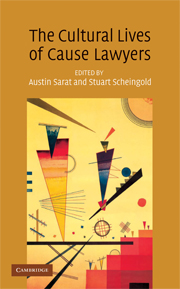Book contents
Bringing Cultural Analysis to the Study of Cause Lawyers: An Introduction
Published online by Cambridge University Press: 08 January 2010
Summary
Introduction
This book seeks to illuminate what we call the cultural lives of cause lawyers by examining their representation in various popular media (including film, fiction, mass-marketed nonfiction, television, and journalism), the work they do as creators of cultural products, and the way those representations and products are received and consumed by various audiences. Attending to media representations and the culture work done by cause lawyers, we can see what material is available for citizens and others to use in fashioning understandings of those lawyers. It also provides a vehicle for determining whether, how, and to what extent cause lawyering is embedded in the discourses and symbolic practices around which ordinary citizens organize their understanding of social, political, and legal life.
This fifth edited volume of the Cause Lawyering Project adds an important new dimension to the body of research that has been growing steadily in the decade since the publication in 1998 of our first volume, Cause Lawyering: Political Commitments and Professional Responsibilities. As we detail below, all of the previous volumes have, in one way or another, focused on the place of cause lawyering in the legal profession and on its political aspirations, activities, and achievements. In contrast to the actions and institutions that were the subject of that research, here we turn to the broader context of cultural “sensibilities” and “mentalities.” This book is but a first step into an area of research rather than the culmination of a research enterprise.
- Type
- Chapter
- Information
- The Cultural Lives of Cause Lawyers , pp. 1 - 24Publisher: Cambridge University PressPrint publication year: 2008
- 3
- Cited by

